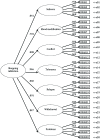The Bergen Shopping Addiction Scale: reliability and validity of a brief screening test
- PMID: 26441749
- PMCID: PMC4584995
- DOI: 10.3389/fpsyg.2015.01374
The Bergen Shopping Addiction Scale: reliability and validity of a brief screening test
Abstract
Although excessive and compulsive shopping has been increasingly placed within the behavioral addiction paradigm in recent years, items in existing screens arguably do not assess the core criteria and components of addiction. To date, assessment screens for shopping disorders have primarily been rooted within the impulse-control or obsessive-compulsive disorder paradigms. Furthermore, existing screens use the terms 'shopping,' 'buying,' and 'spending' interchangeably, and do not necessarily reflect contemporary shopping habits. Consequently, a new screening tool for assessing shopping addiction was developed. Initially, 28 items, four for each of seven addiction criteria (salience, mood modification, conflict, tolerance, withdrawal, relapse, and problems), were constructed. These items and validated scales (i.e., Compulsive Buying Measurement Scale, Mini-International Personality Item Pool, Hospital Anxiety and Depression Scale, Rosenberg Self-Esteem Scale) were then administered to 23,537 participants (M age = 35.8 years, SD age = 13.3). The highest loading item from each set of four pooled items reflecting the seven addiction criteria were retained in the final scale, The Bergen Shopping Addiction Scale (BSAS). The factor structure of the BSAS was good (RMSEA = 0.064, CFI = 0.983, TLI = 0.973) and coefficient alpha was 0.87. The scores on the BSAS converged with scores on the Compulsive Buying Measurement Scale (CBMS; 0.80), and were positively correlated with extroversion and neuroticism, and negatively with conscientiousness, agreeableness, and intellect/imagination. The scores of the BSAS were positively associated with anxiety, depression, and low self-esteem and inversely related to age. Females scored higher than males on the BSAS. The BSAS is the first scale to fully embed shopping addiction within an addiction paradigm. A recommended cutoff score for the new scale and future research directions are discussed.
Keywords: assessment; compulsive buying; personality; psychological distress; psychometrics; scale; self-esteem; shopping addiction.
Figures
References
-
- Aboujaoude E. (2011). Virtually You. The Dangerous Powers of the E-Personality. New York, NY: W. W. Norton & Company, Inc.
-
- American Psychiatric Association. (1994). Diagnostic and Statistical Manual for Mental Disorders, 4th Edn. Washington, DC: American Psychiatric Association.
-
- American Psychiatric Association. (2013). Diagnostic and Statistical Manual for Mental Disorders, 5th Edn. Washington, DC: American Psychiatric Association.
LinkOut - more resources
Full Text Sources
Other Literature Sources
Miscellaneous



